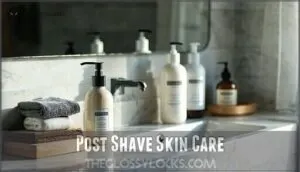This site is supported by our readers. We may earn a commission, at no cost to you, if you purchase through links.

Exfoliate to lift stubborn hairs and clear away dead skin. A warm towel pressed against your beard for a minute works wonders, opening pores and relaxing tough hairs.
For extra softness, massage a little hair conditioner or beard oil into your beard and let it sit for a minute before rinsing.
Once softened, apply a quality shave gel to keep things smooth and prevent irritation. A little prep here saves you from painful razor burn later!
Table Of Contents
- Key Takeaways
- Pre Shave Preparation
- Soften Beard Before Shaving
- Choosing Right Shave Gel
- Effective Shaving Techniques
- Post Shave Skin Care
- Frequently Asked Questions (FAQs)
- How do you soften beard hair before shaving?
- How can I make my beard easier to shave?
- How can I soften my hard beard?
- How to soften face to shave?
- What role does diet play in beard softness?
- Can specific vitamins improve beard hair texture?
- How does stress impact beard health and softness?
- Are steam treatments effective for beard preparation?
- What should I avoid for softer beard hair?
- Conclusion
Key Takeaways
- Wash your face with warm water to open pores and soften your beard for easier shaving.
- Use a pre-shave oil or conditioner to hydrate and soften stubborn stubble before applying shave gel.
- Apply a warm towel to your face for 3-5 minutes to further relax hair follicles and enhance softness.
- Exfoliate 2-3 times a week to remove dead skin and lift stubborn hairs for a smoother shave.
Pre Shave Preparation
Proper preparation before shaving substantially reduces irritation and gives you a smoother result.
You’ll need to soften your beard with warm water or a face wash for at least three minutes before you begin.
Face Wash and Exfoliation
The first step to a silky-smooth shave starts with proper face wash and exfoliation.
Start your journey to a silky-smooth shave by cleansing and exfoliating for refreshed, razor-ready skin.
Use a facial scrub to remove dead skin cells that can clog your razor. Choose a cleanser with ingredients suited for your skin type – gentle for sensitive skin, stronger for oily complexions.
Exfoliation frequency matters too – aim for 2-3 times weekly to prevent irritation while ensuring effective skin exfoliation before shaving. Regular use helps with facial scrub exfoliation for a better shaving experience and to maintain healthy, exfoliated skin with proper facial care.
Hydrating Skin With Warm Water
Before your razor touches your face, proper hydration with warm water is essential for beard softening. Warm water works by opening pores and making hair follicles more pliable.
Here’s how to maximize warm water hydration:
- Spend at least 3 minutes rinsing your face with warm (not hot) water
- Focus on circular motions to stimulate blood flow
- Pay extra attention to thicker beard areas
- Avoid cold water, which closes pores and hardens hair
To further soften the beard, consider applying pre-shave oils to enhance your shaving experience with warm water.
Applying Warm Towel to Face
While warm water starts the softening process, a warm towel takes beard preparation to the next level.
A warm towel unlocks ultimate beard softening, turning your shave into a luxurious, barber-shop-quality experience right at home.
Apply a clean, damp towel (preferably cotton) heated to a comfortable temperature for 3-5 minutes.
The steam opens pores and softens stubborn beard hairs.
For enhanced results, add a few drops of essential oil to your towel.
This classic hot towel shave technique creates barber-shop quality beard softening at home.
Using Hair Conditioner for Softening
While many overlook this bathroom staple, hair conditioner works wonders as a pre-shave beard softener due to its nourishing ingredients.
For maximum beard softening benefits:
- Apply a quarter-sized amount of conditioner to your damp beard
- Massage thoroughly into beard hair for even distribution
- Let it sit for 2-3 minutes before shaving
This technique reduces friction between hair strands, making your razor glide more smoothly and preventing irritation.
Soften Beard Before Shaving
Just like a blacksmith tempers steel, you must properly soften your beard before shaving.
Tackling hard water effects with a warm shower opens pores and hydrates facial hair. Apply beard oil benefits by massaging coconut or olive oil into your stubble for 5-10 minutes.
Alkaline soap use breaks down tough hair proteins, making cutting easier. Wrap your face in a hot towel for 3 minutes to enhance softening.
Natural remedy use works wonders – try honey mixed with almond oil for deep hydration. A good way to hydrate is to use beard conditioners.
Daily beard softening techniques reduce irritation and give you the smoothest possible shave.
Choosing Right Shave Gel
You’ll need the right shave gel to properly soften your beard before taking a razor to your face.
The best products defend against nicks while allowing your razor to glide smoothly, creating a protective barrier that both softens stubborn facial hair and shields sensitive skin, which is crucial for a comfortable shave with sensitive skin.
Selecting Gentle Shave Gel for Sensitive Skin
Five key ingredients make all the difference when selecting a gentle shave gel for sensitive skin.
Look for formulas with glycerin, aloe, and colloidal oatmeal while avoiding fragrances and alcohol.
Hypoallergenic, dermatologist-tested products offer the best protection. For those with scent sensitivity, opt for dye-free, water-based options.
Products like Skintimate and Edge Ultra Sensitive contain beneficial ingredients that help soften your beard while preventing irritation. Many users find a suitable shave product improves their shaving experience with sensitive skin and provides a hypoallergenic solution.
Applying Shave Gel in Thin Layer
The proper application of shave gel requires a thin, even layer for ideal results.
You’ll achieve better razor glide and reduced friction when you apply correctly.
- Use a quarter-sized amount of gel for most faces
- Spread in circular motions for complete skin coverage
- Focus on even application across your entire beard area
- Wait 30 seconds after application for maximum beard softening
Don’t overdo it—excess gel wastes product and clogs razors.
Benefits of Shave Gel With Skin Care Properties
Now that you’ve mastered applying a thin layer, let’s talk about what’s actually in your shave gel.
Shave gels with skin care properties do double duty – they soften your beard while nourishing your skin.
These formulas contain ingredients that boost skin hydration, reduce irritation, and enhance glide during shaving.
They deliver nutrients directly to your skin, promoting long-term health while making your shaving preparation more effective.
Many users find that shave gels with glycerin offer superior skin hydration.
Using Pre Shave Oils for Lubrication
Working oil into your pre-shave routine creates a slick shield between your blade and skin.
Apply 3-4 drops of pre-shave oil to damp skin before shaving cream for maximum beard softening and razor glide.
Pre-shave oil often contains beneficial natural oils like sunflower and jojoba.
- Natural oils like jojoba and grapeseed provide superior lubrication
- Massage oil in circular motions and let sit for 1-2 minutes
- Layer shaving cream on top for enhanced protection
Effective Shaving Techniques
You’ll save your face from looking like a war zone by mastering the right techniques after you’ve properly softened your beard.
Your razor should glide with the direction of hair growth using gentle pressure, helping prevent those painful red bumps that make you look like you’ve wrestled with sandpaper, which can be avoided by using the right techniques and properly softened beard.
Shaving With Grain to Reduce Irritation
For the best shaving experience, always follow your beard’s grain direction.
When you shave with the grain (in the direction your hair grows), you’ll substantially reduce irritation and razor burn.
Map your hair growth pattern before starting—it varies across your face.
This technique mightn’t give the closest shave, but your skin will thank you.
Applying warm water and beard oil in your preshave routine makes this approach even more effective.
Using Light Gentle Strokes for Smooth Shave
Now that you’re shaving with the grain, let’s talk about how you handle your razor.
Light, gentle strokes are your secret weapon for a smooth shave. Don’t press hard—let the razor do the work.
Keep stroke length short and maintain a 30° razor angle against your skin. Apply slight skin tension with your free hand and avoid re-shaving areas to prevent irritation.
Your preshave routine with warm water and beard oil makes these gentle passes even more effective.
Changing Blades Regularly for Optimal Results
A comfortable shave starts with sharp blades. Ignoring Blade Sharpness leads to Shaving Discomfort.
To maintain shaving comfort:
- Replace blades every 7 shaves for Ideal Replacement.
- Practice good Blade Storage to prevent Rust.
- Discard dull blades to avoid irritation.
- Keep extras handy for easy blade maintenance.
Frequent replacement helps, as blade wear is common during regular use. Fresh shaving blades make all the difference, ensuring a comfortable shave and preventing Shaving Discomfort.
Rinsing Razor Frequently for Clean Cut
Keeping your razor clean is like ensuring your car doesn’t run on empty.
Rinse it often with warm water to prevent clogging and remove residue. Clean blades cut smoothly, improving stroke efficiency and reducing irritation.
Plus, regular rinsing promotes blade hygiene and helps soften your beard as warm water flows through. It’s one of the simplest shaving tips to follow!
To further extend the life of your blades, consider proper razor storage to ensure smooth shaves.
Post Shave Skin Care
Post-shave care isn’t just about feeling refreshed—it’s key to keeping your skin healthy and irritation-free.
By using the right products like aftershave balm, moisturizer, and SPF, you can protect your skin and keep it looking its best.
Applying Aftershave Balm to Soothe Irritation
After shaving, rubbing on a soothing aftershave balm can work wonders for irritated skin.
Look for balms with aloe vera or witch hazel to reduce redness and calm sensitive skin.
Gently massage it in—your skin will thank you.
It locks in hydration, boosts skin conditioning, and cuts post-shaving irritation, leaving your face smooth, healthy, and razor-burn-free.
Moisturizing to Retain Hydration and Skin Health
After soothing with aftershave balm, retaining moisture is the key to healthy skin.
Hydration protects sensitive skin and keeps it smooth.
Try these skin hydration techniques:
- Use a lightweight moisturizer with natural balm ingredients.
- Apply beard oil for deep beard hydration.
- Choose products with glycerin for lasting hydration.
- Avoid alcohol-based products that dry skin out.
- Always moisturize immediately after shaving.
Using SPF to Protect Skin From Harmful Rays
While keeping your skin hydrated after shaving is key, don’t skip sunscreen.
Post-shave sunscreen with SPF benefits shields you from harmful UVA/UVB rays that cause sun damage.
It’s a smart step for skin cancer prevention and sun damage repair. Adding this to your skin care routine guarantees better results from beard softening methods and shaving preparation techniques, keeping your skin protected.
Importance of Proper Post Shave Care for Healthy Skin
Post-shave care isn’t optional—it’s key for healthy skin.
Rinse with cool water to close pores, then apply an aftershave balm to reduce irritation.
Lock in hydration by using a moisturizer, especially if you’ve got sensitive skin, and add sunscreen for sun protection, as freshly shaved skin is vulnerable.
These steps keep skin smooth, soothe irritation, and protect your shave prep.
Frequently Asked Questions (FAQs)
How do you soften beard hair before shaving?
Did you know your beard can be as tough as copper wire?
Soften it by washing your face with warm water, applying pre-shave oil, or using conditioner in the shower for a smoother shave.
How can I make my beard easier to shave?
Start by washing your face with warm water or a gentle scrub to open pores.
Apply a pre-shave oil or gel, letting it sit a few minutes.
It softens hair, making shaving smoother and easier.
How can I soften my hard beard?
Hydrate your beard with warm water or a shower, then massage in some pre-shave oil or conditioner.
Let it sit for a few minutes, then apply shaving cream.
This preps your beard perfectly!
How to soften face to shave?
Imagine this: your face needs a warm hug.
Splash it with warm water, exfoliate gently, and apply a softening pre-shave oil.
Let a rich lather sit briefly—this primes your skin for a smooth shave.
What role does diet play in beard softness?
Your diet can affect beard softness more than you’d think.
Eating foods rich in vitamins A, E, and omega-3s keeps hair hydrated and healthy.
Stay hydrated, too—water helps from the inside out.
Can specific vitamins improve beard hair texture?
Think of vitamins like fuel for your beard.
Vitamin E hydrates hair follicles, biotin strengthens hair, and Vitamin D promotes growth.
Add zinc, too—it’s like giving your beard a boost for better texture and softness.
How does stress impact beard health and softness?
Stress can make your beard feel dry and wiry by reducing blood flow and moisture to hair follicles.
Practice relaxation techniques, stay hydrated, and maintain a healthy routine to keep your beard soft and manageable.
Are steam treatments effective for beard preparation?
Steam softens stubborn stubble, opening pores and making shaving seamless.
A hot shower or warm towel mimics spa treatments, prepping your beard efficiently.
It’s like giving your face a quick, mini facial before shaving!
What should I avoid for softer beard hair?
Avoid using harsh soaps or skipping pre-shave prep, like warm water or exfoliating.
Don’t rush or shave dry, as it’ll irritate your skin.
Hard water and neglecting moisturizers also make beard hair stiffer.
Conclusion
Softening your beard before shaving is like paving a smooth road—it makes the journey easier and irritation-free.
By washing, exfoliating, and hydrating your skin with warm water or a towel, you’ll prepare your beard for a closer shave.
Adding a touch of conditioner or beard oil further softens tough hairs.
Don’t forget to use a quality shave gel to keep things smooth.
With these steps, you’ll master how to soften beard before shaving and enjoy effortless, comfortable results.










